What Is A Speakeasy Bar, Why The Name, & Which Is The Most Famous?
Experience a Speakeasy Bar: More than a Relic of the 1920s
By Eben Diskin | Published on October 19, 2022
If there's one period of U.S. history you'd think people would rather not remember, it'd be Prohibition. No one's exactly looking back fondly on the days when alcohol was illegal, and you'd have to tiptoe down a sketchy stairwell in an ill-lit alleyway and duck into a speakeasy bar to enjoy it — all while hoping the police didn't show up. However, it appears that people are more nostalgic for a Prohibition-era drinking experience than you might think. Speakeasy bars are more popular now than ever.
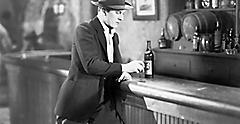

History Of The Speakeasy Bar
Speakeasies arose in the early 1920s, after the U.S. government passed the 18th Amendment prohibiting the manufacture, sale, or transportation of liquor. However, in the wake of World War I, demand for liquor skyrocketed, and a bootleg industry quickly emerged to meet the demand. Alcohol smugglers continued to supply a thirsty nation its drinks of choice, though they had to imbibe undercover — and underground .
Though bars appeared to close up shop, many merely shifted their business to basements, cellars, and attics, and these spots came to be known as speakeasies because patrons often needed to whisper — or "speak easy" — to avoid drawing attention to the illegal operation. Customers would often enter by uttering a password, or performing a secret handshake or knock, to prove that they weren't law enforcement. The speakeasy industry became so popular, it's estimated that over 100,000 of them existed in New York City alone, and they soon became hubs for Jazz music, dancing, and gambling.
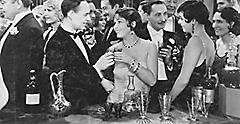
Speakeasies were also a boon for women, who had previously been barred from traditional bars. Newly emboldened by the right to vote, women shed the shackles of conservatism and ventured into the subterranean world of speakeasies. This period of relaxed morals and carefree fun became known as the Jazz Age, and there's no doubt speakeasies helped to cultivate the predominating mood of the era.
Prohibition ended in 1933, and with it the need for underground bars, passwords, and secret handshakes. So, why are speakeasies still so popular in the 21st century?
Book Now

The Allure Of Modern-day Speakeasies
The modern speakeasy bar didn't come into vogue until 1999, when Milk & Honey opened in New York City. The brainchild of bartender Sasha Petraske, Milk & Honey ushered in a revitalization of the speakeasy concept, introducing many fixtures of the modern speakeasy aesthetic. These include a quiet atmosphere, rules of entry ("gentlemen must remove their hats"), a hidden entrance behind a refrigerator, bookcase, or other seemingly mundane objects, bartenders that look the part, and drinks with giant ice cubes. Although Jazz Age speakeasies were home to raucous crowds and debauchery, Milk & Honey was conceived as a quieter alternative to Manhattan's more boisterous bars.
Nowadays, speakeasies aren't just about imbibing in secret. They've played a major role in reviving cocktail culture, making mixology and specialty cocktails a key part of their formula. At Milk & Honey, for example, Petraske wanted to use only high-quality liquors and mixers, and even ice was customized for each cocktail. Speakeasy bartenders are something like celebrity chefs, mixing up unique creations you wouldn't find at the typical Irish pub down the street. It's all part of the speakeasy ethos — discover something others don't know about, and which can't be replicated.
Speakeasy Bar Vs. Alchemist Bar
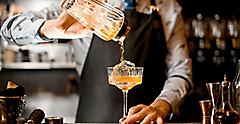
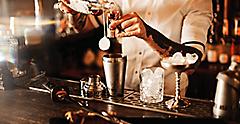
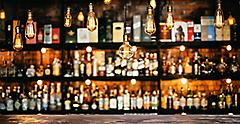
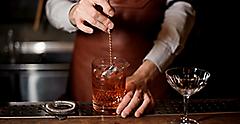
Famous Speakeasy Bars To Visit Near You
Modern-day speakeasies have fun with the secrecy of this culture. Take, for example, Lock & Key in Los Angeles. You probably won't be able to find it on your first stroll down the street. Its location is only evident by an inconspicuous sign of a neon key. After you enter, you'll find yourself opposite a wall of doorknobs, only one of which opens the hidden door to the 20s-themed bar. Don't worry, though — it's worth it. Apothecary 330 in Fort Lauderdale, Florida, is similarly tucked away. You wouldn't expect to find a speakeasy inside a pizzeria, but that's exactly what makes this place so alluring. The high-end bar serves over 300 types of whiskey and is defined by its crystal chandeliers and red leather booths.
Luckily, not all speakeasies are only discoverable through whispers and secret handshakes. Many have become so popular that they're practically fixtures of the cities in which they're located. Simply searching the local maps for your city plus the word speakeasy will most likely return the public speakeasy closest to you if one mentioned here is not nearest to you.
Though typically when you think of speakeasies, we tend to imagine cities like New York and Chicago, where clandestine Prohibition-era drinking exploded in popularity. Fittingly, the PDT speakeasy in New York City is an acronym that stands for "Please Don't Tell." Located behind a phone booth in an East Village hot dog restaurant, the speakeasy is both upscale and incredibly popular with those in the know. To get in, you must enter the phone booth and dial 1 for the door to open. In Chicago, check out the Violet Hour, hidden behind a beautiful painted mural in an alleyway. This high-end speakeasy is surrounded by plush decor and velvet curtains, with a wide range of craft cocktails to choose from.
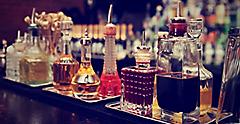
Don't forget about the international speakeasy scene, either. Ladies & Gents in London appears to be located in a public restroom, but as with most speakeasies, not all is as it first seems. Enter through a repurposed Victorian public bathroom and treat yourself to craft cocktails made from the bar's own copper still. Once you see the immersive interior aesthetic, you won't believe you entered through a bathroom. Speakeasy culture has made its way all the way to Asia, too. Located behind a plain white door with no signage in Singapore, 28 HongKong Street is known not only for its true-to-history 20s-era decor, but also for its drinks. Its bartenders are famous for their mixology skills and for signature cocktails such as the Crimson & Clover — a drink with gin, berries, thyme, basil, and lemon.
Prohibition may be just a memory of American history, but there are iconic speakeasies located all around the world. Step into a secret velvet-draped bar, and hearken back to the glitz and glamour of the roaring twenties.





